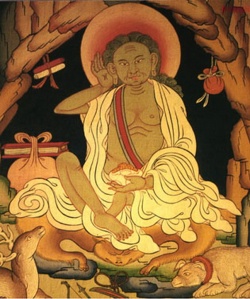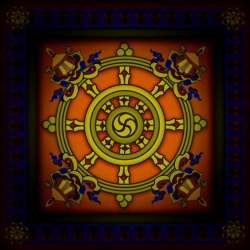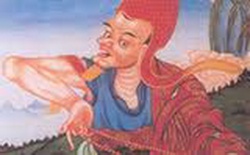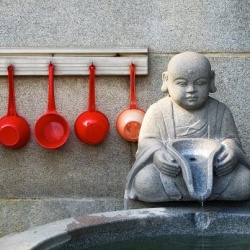Difference between revisions of "Eight Legions"
| Line 28: | Line 28: | ||
[[Karura]] (Skt: [[Garuda]]) Bird-man, enemy of [[dragons]] | [[Karura]] (Skt: [[Garuda]]) Bird-man, enemy of [[dragons]] | ||
[[Kinnara]] (Skt: [[Kimnara]]). [[Celestial musicians]] & dancers; [[human form]] with [[horse’s]] head; commanded by [[Tamonten]] ([[Shitennō]]) | [[Kinnara]] (Skt: [[Kimnara]]). [[Celestial musicians]] & dancers; [[human form]] with [[horse’s]] head; commanded by [[Tamonten]] ([[Shitennō]]) | ||
| − | Magoraka (Skt: [[Mahoraga]]). [[Serpentine musicians]] | + | [[Magoraka]] (Skt: [[Mahoraga]]). [[Serpentine musicians]] |
</poem> | </poem> | ||
Latest revision as of 13:49, 24 November 2015
The Eight Legions are a curious grouping of Buddhist protectors, demons, and spirits.
Among the eight groups, only the Ten (Skt. Deva) and Ryū (Skt. Naga; serpent-like creatures, including Dragons) appear with great frequency in Japanese sculpture and artwork, while the other six are represented much less so.
As a group, the Hachi Bushu are not objects of Buddhist worship, although some individual Ten (Deva) are given independent status as objects of devotion (e.g., Bishamonten, Benzaiten, Daikokuten).
Ten (Skt: Deva). Celestial beings, 6th level of existence
Ryū (Ryu, Ryuu) (Skt: Naga). Serpent-like creatures, including dragons. Attendants to Kōmokuten (Shitennō)
Yasha (Skt: Yaksa). Warriors of Fierce Stance, Nature Spirits.
Protect Yakushi Nyorai, commanded by Tamonten (Shitennō)
Kendatsuba (Skt: Gandharva). Gods of music, medicine, children. Commanded by Jikokuten (Shitennō); one of their kings is Sendan Kendatsuba
Ashura (Skt: Asura). Demigod, 4th level of existence
Karura (Skt: Garuda) Bird-man, enemy of dragons
Kinnara (Skt: Kimnara). Celestial musicians & dancers; human form with horse’s head; commanded by Tamonten (Shitennō)
Magoraka (Skt: Mahoraga). Serpentine musicians
The Hachi Bushū (Eight Legions) are eight groups of sentient and supernatural beings said to be present when Shaka Nyorai (Historical Buddha) expounded the Flower Sutra on Vultures Peak (also called Eagle Peak).
They originated in earlier Hindu mythology, but converted to Buddhism after listening to the words of Shaka Nyorai, there after becoming guardians of Buddhist teachings.
Two of the eight -- the Ashura (Demigods) and Ten (Deva) -- also populate two of the six states of existence. The lowest three states are called the three evil paths, or three bad states.
They are:
(1) people in hells;
(2) hungry ghosts;
(3) animals.
The highest three states are:
(4) Asura; (5) Humans; (6) Deva.
All beings in these six states are doomed to death and rebirth in a recurring cycle over countless ages -- unless they can break free from desire, from the cycle of suffering (Skt. = Samsara).
Hachibushuu is an abbreviation of Tenryuu Hachibushuu 天竜八部衆.
Eight classes of Indian deities who were converted by Shaka (Historical Buddha) and came to be considered protectors of the Dharma (Buddhist Law).
They appear in many texts, including the HOKEKYOU 法華経 (Lotus Sutra), and are named as follows:
Ten 天 (Deva), Ryuu 龍 (Naga), Yasha 夜叉 (Yaksa), Kendatsuba 乾闥婆 (Gandharva), Ashura 阿修羅 (Asura), Karura 迦楼羅 (Garuda), Kinnara 緊那羅 (Kimnara), and Magoraka 摩ご羅伽 (Mahoraga).
The names are not fixed, and an individual deity may sometimes represent their class.
The most famous set in Japan was made of dry lacquer in 734 AD and once accompanied an image of Shaka Buddha.
There is also a set of sculptures of Shaka's disciples in Koufukuji 興福寺 (Nara). Temple tradition gives their names as Gobujou 五部浄 for the [Ten]], Shagara (or Sakara) 沙羯羅 for the Ryuu, Kubanda 鳩槃荼 for the Yasha, Kendatsuba, Ashura, Kinnara, and Hibakara 畢婆迦羅, probably for the Magoraka.
The Hachibushuu usually appear amidst groups, such as the group of figures surrounding Shaka in paintings of his death (Nehan-zu 涅槃図). They were shown as a distinct group only in the Nara period.



